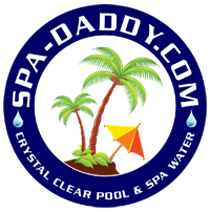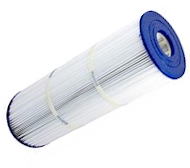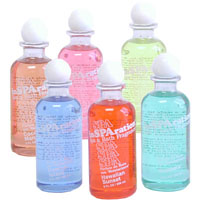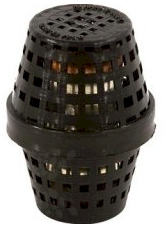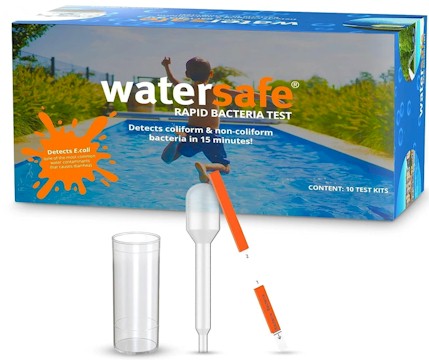|
|
269-978-1983
|
| |
|
|
|
|
|
|
|
|
|
|
|
|
|
|
Popular Products:
|
|
|
|
|
|
|
|
|
|
|
| |
|
Filter Cartridge Cleaning and Maintenance
At some point in time (usually about one year) filters need to be replaced.
Finding the correct replacement filters can be a chore, so we make it easy. Just go to our
3 Easy Ways To Identify Your Pool or Spa Filter Page
to quickly find the correct replacement for your existing filter.
How can I tell when a Filter Cartridge needs to
be replaced?
With no moving parts or electrical switches to fail, Filters
Cartridges do not have a defined end-of-life. Instead media
will gradually plug up over time.
In a typical spa, the culprit that plugs the media is perspiration
and body oils combined with soaps, chemicals and very fine
particulate. In a swimming pool, the loading is primarily
debris along with suntan lotions and organic matter such
as algae.
Assuming the Filter is properly maintained and correctly
sized to the pump, determining when the Filter Cartridge
is exhausted depends primarily upon three factors:
-
Shorter cycle time between cleanings
-
Low water flow rate and high differential pressure
-
Catastrophic failure such as a tear in the media or center core collapse
All three are dependent upon proper pool or spa water chemistry
and following a routine maintenance schedule. Filter elements
are plastic and should be handled and maintained accordingly.
How do I maximize the life of a filter cartridge?
• Clean the elements per manufacturers cleaning instructions
• Never use a stiff brush to clean the media
• Maintain your pool or spa water chemistry in proper balance
• Alternate two sets of filter crtridges when cleaning
For swimming pools, clean the cartridge when filter canister
pressure reaches 8 PSI above the initial system or new cartridge
starting pressure. For spas, establish a routine cartridge
cleaning schedule based on the amount of spa usage. If Baquacil
is used as a sanitizer, the filter element must be cleaned
with Baqua Clean before any cartridge cleaner is used.
How do I clean my filter cartridge?
-
Remove the cartridge from the filter housing following
the manufacturer's instructions
-
Use a garden hose with a straight flow nozzle to wash
down the filter element.Work from the top down, holding
the nozzle at a 45 degree angle, and wash all the pleats
with emphasis between the pleats.
We use our Filter Flosser,
the best cleaning tool on the market.
IMPORTANT: DO NOT use a stiff brush as this will damage your filter.
-
Rinse until all dirt and debris is gone
-
For all spa cartridges and elements used in swimming
pools where perspiration, suntan lotions, and other oils
are present, soak the element for at least one hour (overnight
is most effective) in a commercial filter cleaner.
-
Rinse the cartridge again to remove oils and cleaning solution.
-
If the filter has a coating of algae, calcium carbonate
(residue from calcium hypo chlorite), iron, or other minerals,
soak the cartridge in a solution of one part muriatic acid
to twenty parts water until all bubbling stops.
If Baquacil is used as a sanitizer, the filter element must be cleaned
with Baqua Clean before any cartridge cleaner is used.
-
Rinse the filter cartridge clean and reassemble housing.
What are the different types of filtration for
a Pool or Spa?
There is a lot of confusion about various filters, and many
different opinions. Here are a few facts to consider. The
first is that a pool can be properly maintained with any
of the filter systems available: Filter Cartridge, Sand
or Diatomaceous Earth Swimming Pool Filter Systems. Here
is a brief description of each type:
-
Filter Cartridge (The economic low maintenance filter).
This one is easy to understand. Water passes though a filter
material and the filter captures the debris. This is just
like the water filters used under your sink. Cartridges
have much more available area to filter than sand. Most
start at 50 Sq.ft and the majority of the cartridge filters
sold are larger than 100 Sq.ft. Cartridge Filters are designed
to run at lower pressure than sand. This puts less back-pressure
on the pump and hence you get more flow and turnover for
an equivalent pump size. Generally these filters have to
be cleaned once or twice a season by simply hosing them
off, so you don't touch them as often. In terms of particle
size filtered out, cartridge is somewhere between sand and
DE.
-
Sand (The older style filter)
Water is pushed through a bed of filter sand and removed
through a set of lateral tubes at the bottom. The filter
area of a sand filter is equal to the area of the filter
itself. For example, a 24" filter will have 3.14 sqft of
filter area. Only the top 1" of sand is actually used to
filter the water. The principle behind this filter is that
water is pushed through the filter sand, somewhat like an
espresso machine. Dirty water goes in the top and clean
water exits out the bottom.
As the filter sand becomes plugged with debris from the
pool, the pressure increases on the filter and the water
flow drops. In order to clean the filter, you just run it
in reverse and dump the waste water; this is referred to
as "back washing" the filter. Once the filter is back washed,
you move to the rinse mode and that repacks the sand and
then back to filter. This has to be done manually every
few weeks. From a hydraulics standpoint, a backwash valve
is typically the most inefficient piece of equipment you
can add to a swimming pool system. Should the sand ever become
really dirty, it is easily and inexpensively replaced. In
terms of particle size filtered out, sand is the lease effective
method - it can allow smaller particles to pass back into
the pool.
-
DE (Low-usage alternative)
Diatomaceous earth is mined and is the fossilized exoskeletons
of tiny diatoms. They are used to coat "grids" in the filter
housing and act as tiny sieves to remove debris. They are
very small and as such can filter out particles as small
as 5 microns. Diatom filter area are sized between sand
and cartridge - around 60-70 sq ft are most common. Once
the filter pressure rises, the filter is back washed just
like a sand filter and then "recharged" with more DE powder.
Typically it is poured in a slurry into the skimmer and
it then coats the filter grids. DE filters run at higher
pressures than cartridge filters and as such can lead to
some inefficiency and flow loss.
NOTE* Spa-Daddy does not recommend the use of diatomaceous
earth (DE) with cartridge filters. DE Particles will become
trapped in the body of the media and shorten cartridge life.
(Resource: Ray Cronise: about.com)
|
